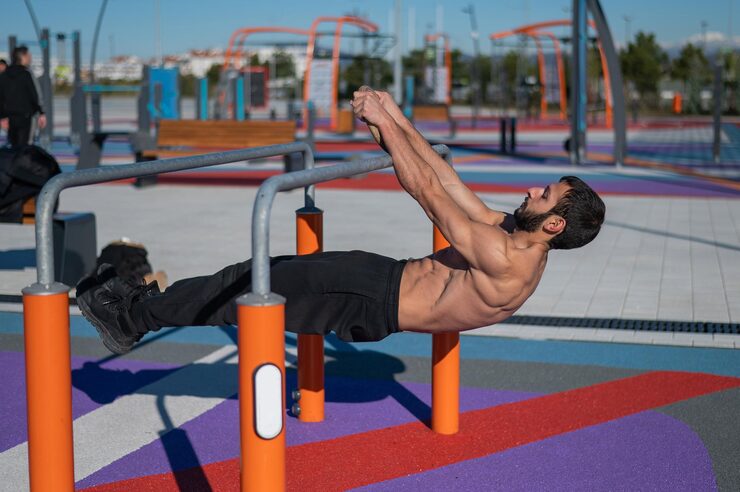Sports Core Strength Workouts are essential for athletes, fitness enthusiasts, and anyone looking to improve overall stability and power. A strong core is more than just visible abs—it’s the foundation of functional strength, balance, and injury prevention. Incorporating targeted exercises into your training routine can transform performance in almost every sport and physical activity.
From football players to gymnasts, core strength influences agility, coordination, and endurance. Without it, even the most skilled athletes can struggle with stability and power output, leading to suboptimal performance or increased risk of injury.
Why Core Strength Matters in Sports
The core consists of muscles in the abdomen, lower back, hips, and pelvis. These muscles work together to support posture, enable efficient movement, and transfer force between the upper and lower body. Whether swinging a tennis racket, throwing a football, or performing a squat, a strong core enhances control and reduces strain on joints.
Sports Core Strength Workouts focus on activating these muscle groups in a functional way, emphasizing stability under dynamic movement rather than just static strength. For instance, a soccer player relies on core stability to maintain balance while pivoting or sprinting, while a swimmer uses core engagement to maintain streamlined body position in water.
Foundational Exercises for Core Power
Planks, side planks, and bird-dogs are fundamental exercises that train endurance, stability, and anti-rotation strength. These moves teach the body to maintain alignment under pressure, preparing it for more advanced movements.
For athletes, integrating rotational exercises like medicine ball twists or cable rotations is key. These mimic real-life sports actions and improve force transfer from the core to the limbs. Basketball players, for example, benefit from rotational core strength when passing or shooting, as the torso generates and directs power efficiently.
Dynamic Core Workouts
Dynamic movements take core training to the next level by combining strength with movement patterns found in sports. Mountain climbers, kettlebell swings, and TRX rollouts challenge balance, endurance, and coordination simultaneously. These exercises activate multiple muscle groups, creating a responsive, strong, and agile core.
Real-life athletes often incorporate dynamic core routines into their warm-ups or circuits to enhance both performance and injury prevention. For instance, a gymnast may perform controlled rollouts on a stability ball to prepare for tumbling passes while maintaining spinal integrity.
Integrating Core Strength Into Full-Body Training
While isolated core exercises are valuable, integrating them into full-body workouts maximizes functional strength. Movements such as squats, deadlifts, and overhead presses engage the core to stabilize the torso while generating force in the limbs.
By consciously activating the core during these lifts, athletes develop a deeper connection between strength and movement efficiency. Martial artists, for example, rely on a braced core to maintain balance and generate power during strikes and kicks.
Progressive Overload and Variation
To continually improve, Sports Core Strength Workouts should evolve in intensity and complexity. Adding weight, increasing duration, or incorporating unstable surfaces like balance discs or Bosu balls challenges the core in new ways.
Athletes also benefit from sport-specific variations. A golfer may focus on rotational medicine ball throws to mimic swings, while a runner emphasizes anti-rotation planks to stabilize the pelvis during stride. Progressive overload ensures continuous adaptation, preventing plateaus and fostering long-term performance gains.
Injury Prevention and Rehabilitation
A well-developed core not only enhances performance but also protects the body from injuries. Weak or imbalanced core muscles can lead to lower back pain, knee stress, or shoulder instability. Incorporating stability-focused exercises helps strengthen supportive muscles, improving posture and movement mechanics.
Physical therapists often prescribe core strengthening as part of rehabilitation programs for athletes recovering from back or hip injuries. These workouts rebuild strength while promoting proper alignment and functional movement patterns.
Real-Life Athlete Examples
Professional athletes across sports prioritize core strength to optimize performance. Tennis players rely on explosive rotational power generated by the core, while sprinters need strong midsections for stride efficiency. Even team sport athletes, such as football and basketball players, engage in core circuits to maintain balance and react quickly on the field.
A collegiate swimmer shared how daily core routines including planks, Russian twists, and flutter kicks enhanced her stroke efficiency, enabling longer sets with better technique. These examples illustrate the practical impact of targeted core workouts on athletic success.
Holistic Approach to Core Training
Effective Sports Core Strength Workouts are part of a broader fitness strategy. Nutrition, recovery, flexibility, and mobility play crucial roles in developing and maintaining a strong core. Stretching tight hip flexors or performing yoga can complement strength exercises, ensuring balanced development and reducing the risk of overuse injuries.
Integrating mindfulness and body awareness also enhances performance. Athletes learn to engage their core consciously, translating strength gains from isolated exercises to sport-specific movements seamlessly.
Read also:
panera bread menu
dairy queen menu
tirupati courier tracking status online
tirupati courier tracking status
tirupati courier tracking shipway
tirupati tracking number
